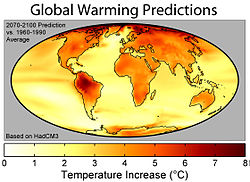
File:Global Warming Predictions.png
| |
This is a file from the Wikimedia Commons. Information from its description page there is shown below.
Commons is a freely licensed media file repository. You can help. |
Contents |
Summary

See also: w:economics of global warming#Scenarios
Shows climate model predictions for global warming under the SRES A2 emissions scenario(vague – see talk page) relative to global average temperatures in 2000. The A2 scenario family is characterized by a politically and socially diverse world that exhibits sustained economic growth but does not address the inequities between rich and poor nations, and takes no special actions to combat global warming or environmental change issues. This world in 2100 is characterized by large population (15 billion), high total energy use, and moderate levels of fossil fuel dependency (mostly coal). The A2 scenario was the most frequently studied of the SRES scenarios at the time of the IPCC Third Assessment Report.
In total, there are forty SRES scenarios, and they are grouped into six scenario "families": A1B, A1FI, A1T, A2, B1 and B2 (Morita et al., 2001:143-147). Each group has an illustrative "marker" scenario.
No likelihood has been attached to any of the SRES scenarios (IPCC, 2007b:44). The SRES scenarios do not include additional climate initiatives, which means that no scenarios are included that explicitly assume implementation of the United Nations Framework Convention on Climate Change or the emissions targets of the Kyoto Protocol (IPCC, 2007a:18).
For the six SRES marker scenarios, IPCC Fourth Assessment Report (2007:7-8) gave a "best estimate" of global mean temperature increase (2090-2099 relative to the period 1980-1999) that ranged from 1.8 °C to 4.0 °C. Over the same time period, the IPCC gave a "likely" range (greater than 66% probability, based on expert judgement) for these scenarios was for a global mean temperature increase of between 1.1 and 6.4 °C. These ranges stem from a combination of uncertainty over future emissions and variations between models regarding the expected response to a given set of emissions. The figure above, showing the disagreement among models for a single scenario, illustrates the latter kind of uncertainty. The lowest temperature increase was for the B1 marker scenario, where the best estimate warming was 1.8 °C (1.1 to 2.9 °C likely range). The highest increase was for the A1F1 marker scenario, of 4.0 °C (2.4 to 6.4 °C likely range). For the A2 marker scenario, the best estimate was 3.4 °C (2.0 to 5.4 °C likely range).
| Temperature Increase 2000 to 2100 (°C) | |||
|---|---|---|---|
| Model | Total | Land | Ocean |
| CCSR/NIES | 4.7 | 7.0 | 3.8 |
| CCCma | 4.0 | 5.0 | 3.6 |
| CSIRO | 3.8 | 4.9 | 3.4 |
| Hadley Centre | 3.7 | 5.5 | 3.0 |
| GFDL | 3.3 | 4.2 | 3.0 |
| MPI-M | 3.0 | 4.6 | 2.4 |
| NCAR PCM | 2.3 | 3.1 | 2.0 |
| NCAR CSM | 2.2 | 2.7 | 2.0 |
References
- ↑ IPCC (2000). An Overview of Scenarios. In: IPCC Special Report on Emissions Scenarios [N. Nakicenovic and R. Swart (eds.)]. Cambridge University Press, U.K.. Retrieved on 2010-03-03.
- ↑ Morita, T. et al. (2001). Greenhouse Gas Emission Mitigation Scenarios and Implications. In: Climate Change 2001: Mitigation. Contribution of Working Group III to the Third Assessment Report of the Intergovernmental Panel on Climate Change [B. Metz et al. Eds.]. Cambridge University Press, Cambridge, U.K., and New York, N.Y., U.S.A.. Retrieved on 2010-01-10.
- ↑ IPCC (2007). Climate Change 2007: Synthesis Report. Contribution of Working Groups I, II and III to the Fourth Assessment Report of the Intergovernmental Panel on Climate Change [Core Writing Team et al. (eds.)]. IPCC, Geneva, Switzerland. Retrieved on 2009-05-20.
- ↑ IPCC (2007a). Summary for Policymakers. In: Climate Change 2007: The Physical Science Basis. Contribution of Working Group I to the Fourth Assessment Report of the Intergovernmental Panel on Climate Change [Solomon, S. et al. (eds.)]. Cambridge University Press, Cambridge, U.K., and New York, N.Y., U.S.A.. Retrieved on 2009-05-20.
Models
The model data used above was taken from the IPCC-DDC, and the models are as follows:
- CCSR/NIES: Centre for Climate System Research & National Institute for Environmental Studies, , CCSR/NIES AGCM + CCSR OGCM Models 1890-2100
- CCCma: Canadian Centre for Climate Modelling and Analysis , CGCm2 Model 1900-2100
- CSIRO: Commonwealth Scientific and Industrial Research Organisation , CSIRO-Mk2 model 1961-2100
- Hadley Centre: Hadley Centre for Climate Prediction and Research , HADCM3 model 1950-2099
- GFDL: Geophysical Fluid Dynamics Laboratory , R30 Model 1961-2100
- MPI-M: Max Planck Institute für Meteorologie , ECHAM4/OPYC coupled model 1990-2100
- NCAR PCM: National Centre for Atmospheric Research , PCM model 1980-2099
- NCAR CSM: National Centre for Atmospheric Research , CSM Model 2000-2099
Copyright
This figure was created by Robert A. Rohde from public data and is incorporated into the Global Warming Art project.
 |
Permission is granted to copy, distribute and/or modify this document under the terms of the GNU Free Documentation License, Version 1.2 or any later version published by the Free Software Foundation; with no Invariant Sections, no Front-Cover Texts, and no Back-Cover Texts. A copy of the license is included in the section entitled GNU Free Documentation License. http://www.gnu.org/copyleft/fdl.htmlGFDLGNU Free Documentation Licensetruetrue |
| This file is licensed under the Creative Commons Attribution-Share Alike 3.0 Unported license. | ||
|
||
| This licensing tag was added to this file as part of the GFDL licensing update.http://creativecommons.org/licenses/by-sa/3.0/CC-BY-SA-3.0Creative Commons Attribution-Share Alike 3.0 truetrue |
File usage
Metadata
| Software used |
|
|---|
Schools Wikipedia facts
Schools Wikipedia was created by children's charity SOS Children. SOS Children's Villages believes that a decent childhood is essential to a happy, healthy. Our community work brings families new opportunities through education, healthcare and all manner of support. There are many ways to help with SOS Children.

